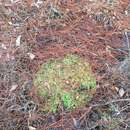Comments
provided by eFloras
The compact growth form in thin but dense mats and occurrence in often dessication-prone sites distinguishes Sphagnum perichaetiale from any other species of sect. Sphagnum. The often quite stiffly spreading branch leaves give it a strong resemblance to S. compactum, but the latter’s small triangular stem leaves will readily distinguish that species. The branch leaf hyaline cells of S. perichaetiale have only a few pores on their convex surface, and they are typically small, thickened, and grouped in 3s where the cell corners meet. Similar species in sect. Sphagnum have more pores along the commissures, and they are more elliptical and not thickened. The often hemiisophyllous stem leaves are also diagnostic of S. perichaetiale within the section.
- license
- cc-by-nc-sa-3.0
- copyright
- Missouri Botanical Garden, 4344 Shaw Boulevard, St. Louis, MO, 63110 USA
Comments
provided by eFloras
This species is similar to Sphagnum magellanicum, but it differs in having smaller and flat stem leaves (twice as small as the branch leaves) and in having the hyaline cells of stem leaves with obscure pores.
- license
- cc-by-nc-sa-3.0
- copyright
- Missouri Botanical Garden, 4344 Shaw Boulevard, St. Louis, MO, 63110 USA
Description
provided by eFloras
Plants ± moderate-sized, compact and stiff-stemmed; forming dense to somewhat loose low cushions in often seasonally dry depressions. Stems brown; superficial cortical layer with spiral reinforcing fibrils faint to obvious, 1-3 pores per cell, comb-fibrils lacking on interior wall. Stem leaves to 1.1 × 0.7 mm, commonly hemiisophyllous; hyaline cells non-ornamented, mostly 1-2-septate. Branches short and blunt at distal end, leaves loosely spreading. Branch fascicles with 2 spreading and 1-2 pendent branches. Branch stems with hyaline cells non-ornamented, no or weak funnel-like projection of end walls of cortical cells, cortical cells with one large pore per cell on superficial wall. Branch leaves ovate, to 2.2 × 1.1 mm; ovate, hyaline cells non-ornamented, on proximal half of convex surface with small ringed pores or pseudopores in groups of three where the corners join and pseudopores along the commissures; chlorophyllous cells narrowly rectangular, lenticular to narrowly trapezoidal in transverse section; exposed equally on both surfaces or more broadly on concave surface; end walls not thickened. Sexual condition dioicous. Capsule with numerous pseudostomata. Spores 25-39 µm; surface smooth to irregularly and finely papillose; indistinct Y-mark on distal surface; proximal laesura more than 0.6 spore radius.
- license
- cc-by-nc-sa-3.0
- copyright
- Missouri Botanical Garden, 4344 Shaw Boulevard, St. Louis, MO, 63110 USA
Description
provided by eFloras
Plants moderately robust, soft, pale green or yellowish brown, tinged with purple, in dense tufts. Stem cortex in 2–4 layers, hyaline cells thin-walled, sparsely fibrillose and porose; central cylinder reddish brown. Stem leaves 0.7–1.0 mm × 0.5–0.6 mm, short and small, flat, short ligulate, rounded and dentate at the apex; hyaline cells broadly rhomboidal, often divided, without fibrils and pores, or rarely fibrillose and porose in the upper cells. Branches in fascicles of 3–5, with 2–3 spreading. Branch leaves 1.6–2.0 mm × 1.2–1.4 mm, broadly ovate, strongly concave, margins involute in the upper half, cucullate-concave and dorsally roughened at the apex; hyaline cells rhomboidal, with large, rounded, unringed pores on the ventral surface, more pores in the upper cells, with few elliptic, ringed pores at the opposite ends on the dorsal surface; green cells in cross section narrowly elliptic, centrally located, slightly and equally exposed on both surfaces. Dioicous. Sporophytes not seen.
- license
- cc-by-nc-sa-3.0
- copyright
- Missouri Botanical Garden, 4344 Shaw Boulevard, St. Louis, MO, 63110 USA
Distribution
provided by eFloras
Distribution: China, Himalayas, India, Thailand, Cambodia, Vietnam, Indonesia, Malaysia, the Philippines, Europe, North, Central, and South America, South Africa, and Madagascar.
- license
- cc-by-nc-sa-3.0
- copyright
- Missouri Botanical Garden, 4344 Shaw Boulevard, St. Louis, MO, 63110 USA
Habitat
provided by eFloras
Habitat: in bogs, on wet ground under forests; also submerged in water on grasslands.
- license
- cc-by-nc-sa-3.0
- copyright
- Missouri Botanical Garden, 4344 Shaw Boulevard, St. Louis, MO, 63110 USA
Synonym
provided by eFloras
Sphagnum brevicaule Warnstorf; S. cymbifolium var. ludovicianum Cardot; S. harperi Warnstorf; S. ludovicianum (Cardot) Warnstorf
- license
- cc-by-nc-sa-3.0
- copyright
- Missouri Botanical Garden, 4344 Shaw Boulevard, St. Louis, MO, 63110 USA
Synonym
provided by eFloras
Sphagnum attenuatum Dix., J. Bot. 79: 57. 1941.
Sphagnum beccarii Hampe, Nuovo Giorn. Bot. Ital. 4: 278. 1872.
Sphagnum fleischeri Warnst., Hedwigia 57: 77. 1915.
Sphagnum griffithianum Warnst., Hedwigia 30: 151. 1891.
Sphagnum holttumii A. Johnson, Gard. Bull. Singapore 17: 320. 1959.
Sphagnum japonicum Warnst. var. philippinense Warnst., Sphagn. Univ. 520. 1911.
Sphagnum pauciporosum Warnst., Hedwigia 39: 109. 1900.
Sphagnum roseotinctum A. Johnson, Gard. Bull. Singapore 17: 320. 1959.
- license
- cc-by-nc-sa-3.0
- copyright
- Missouri Botanical Garden, 4344 Shaw Boulevard, St. Louis, MO, 63110 USA

